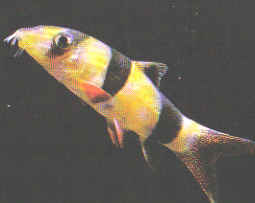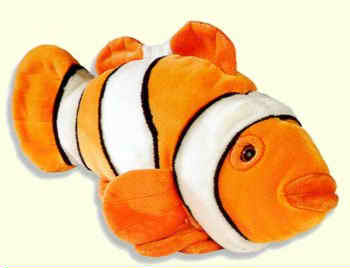|
|
Clown Loaches
William Berg
Scientific Name: Botia macracanthus
Other Scientific Name(s): Cobitis macracanthus, Botia
macrocanthus
Common Name: Clown Loach
Clown loaches are very popular aquarium fish; however they are
not always easy to keep successfully. They easily succumb to
ick and are sensitive to poor water conditions. This article is
intended to help new clown loach owners provide a good home for
their loaches. Clown loaches are found in Indonesia (Sumatra and
Borneo), and almost all clown loaches in aquariums are wild
caught and distributed around the world before being sold. This
can put considerable stress on the fish, and a vital step in
getting a healthy clown loach school in your aquarium is choosing
healthy fish. But how to make sure that you get healthy fish?
- Check the general conditions in the fish store. Are there dead
fish in the aquariums? Is the water clean? If some tanks are
mistreated there is a good chance that there might be
unfavorable conditions in others too. Only buy fish from stores
that take good care of their aquariums.
- How do the clown loaches look? Clown loaches can give you an
indication of their condition based on their coloration. A
healthy clown loach shows clear distinct colors, while a
stressed one loses its colors and becomes whiter. Only buy
loaches that show their correct colors.
- Are the clown loaches well fed? Those that haven't been fed
correctly are hard to nurse back to health, and it is more than
likely you will end up with a dead fish if you buy one. Look at
their bodies and see if they look well fed, and ask the
shopkeepers how often and what the loaches are fed.
- Are the clown loaches active? Healthy clown loaches are very
active and full of energy. A healthy clown loach should be hard
to catch.
- Do the clown loaches have hiding places? Hiding places are very
important to relieve stress in clown loaches, and you are likely
to get higher quality fish from aquariums with hiding places.
- Don't buy clown loaches smaller than 2 inches/5 cm if you
haven't kept clown loaches before, since they are much more
sensitive when they are younger.
So ideally you should look for the most colored, most active
clown loaches you can find, and buy these to have the best
starting point possible. You should also consider the water
conditions in the store and try to find one that keeps their
clown loaches in water condition similar to the water conditions
in your aquarium, to reduce stress on the clown loaches. It
should also be stated that clown loaches like resting on their
sides, looking almost as if they were dead. However this is
completely normal and should not be seen as a sign of poor
quality in the fish but rather the opposite. When you have
decided where to buy your clown loaches you should buy at least 3
(preferable 8-10). Clown loaches are schooling fish that should
never be kept alone!!!
Once you get home with your new clown loaches you should let the
bag float on the water surface for 10-15 minutes, and then slowly
every 10 minutes add a little water from the aquarium (a coffee
cup). Repeat this 4-5 times before you release the fish into
their new home.
Picture Clown Loach Fish

Tank setup for Clown Loaches
Clown loaches can be kept in aquariums of 100 L / 20 G or more.
Keep in mind that even though clown loaches grow very slowly they
will get big eventually and need an aquarium of at least 540 L/
125 G, and that should be considered a minimum.
Decorate your aquarium using a bottom substrate of sand or fine
gravel that allows the clown loaches to dig . I recommend keeping
your clown loaches in a planted aquarium, however the choice of
plants differs greatly depending on whether you keep juvenile or
adult clown loaches. Juvenile clown loaches can be kept with most
plant species, while adults can be kept only with hardy plants
such as Java fern and Anubias. All other plants will be destroyed
and/or eaten by the adult clown loaches. I also recommend using
floating plants to dim the lighting, which makes the loaches more
active during the day.
Clown loaches want a setup with a lot of caves and other hiding
places, preferably so narrow that they can just barely squeeze
themselves into them. Don't be concerned if your clown loaches
have squeezed themselves into caves they dug under rocks or
aquarium equipment. Odds are they are not stuck - they just like
it that way.
Hiding places can be created with rocks, roots, PVC pipes, flower
pots, coconuts and different kinds of aquarium decorations. Sharp
objects should not be used to decorate aquariums for clown
loaches. You can not create too many hiding places and you should
create several for each loach.
Clown loaches are sensitive to poor water quality, and they
require good filtration. Higher water circulation is also
appreciated since clown loaches live in currents in the wild.
Clown loaches are excellent jumpers, and you should make sure
that your tank is properly sealed.
Health
As I said earlier, clown loaches are very sensitive towards poor
water quality and are usually the first fish that get ill or die
if the water quality drops. Water changes of at least 25% a week
are recommended. Because of their low tolerance to poor water
qualities they are sometimes called indicator fish, since their
health indicates the status of the aquarium. Clown loaches are
very sensitive to chlorine, and even small amounts can cause a
mass death of loaches.
This species are very prone towards getting ick if the water
quality isn't good enough, and are sensitive to most ick
medicines and salts. So keep an eye on your clown loaches and
only use half the recommended doses of medicine, otherwise you
risk the medicine killing the loaches.
Food for Clown Loaches
Clown loaches are carnivores and only eat vegetables to
complement their diet. It is therefore recommended that they are
given food that reflects this. To get your clown loaches to grow,
optimal feeding 3-5 times a day is recommended. (They still grow
slowly). Their diet should contain a variety of foods, and can
include almost any carnivorous food. A good base may be shrimps,
different sinking wafers, different frozen foods, and as they
grow older, fish slices. Clown loaches can make a clicking sound,
and they will do this when they are content. Therefore you will
soon find out what is your loaches' favorite food by them
clicking when they receive it. Like most other fish, clown
loaches might need some time to accept new foods, however once
they do it might become a favorite. Clown loaches are one of the
few fishes that eat and like snails, and can therefore be of good
use in snail control.
Breeding Clown Loaches
Clown loaches have been bred in aquariums, however it is very
rare. Finding the gender of clown loaches externally is hard, but possible by
looking at the tail fin. The tail fin tips on the male are
slightly bent inwards, making the fin look a little bit like a
claw. The tail fin tips on the females aren't shaped like this.
Clown loaches have to be quite old and at least 7 inches / 17 cm
before they are mature. In the one good account of clown
loaches spawning they spawned under the following conditions:
- Temp: 84F
- pH: 6.5
- Ammonia & Nitrite: 0
- Nitrate: < 25
Four large clown loaches (over 25 cm /10 inches) were kept
together in a planted aquarium, and a few weeks before spawning
they changed their behavior and started eating live fish as
their only accepted food. The females in the group grew very fast
on this diet, and had doubled in girth by the time of spawning.
The night during which the spawning took place, two clowns were
swimming close beneath the surface entwined in each other and
"clicking." The next morning, 450 eggs were found spread about
the aquarium. Clown loaches eat their own eggs, so it is
recommended moving the parents if you wish to succeed in spawning
them.
The fry were fed liquid fry food for the first two weeks, after
which they accepted crushed flakes. They grew relatively fast, to
2.5 cm/ 1 inch in 6 weeks. After that the growth rate slowed
down.
It's suggested that older fish are essential for breeding since
this fish might have to be quite old to be mature. Clown
loaches live to be about 50 years, so it is quite feasible that
they may spawn later in life than many other species.
William Berg has over 20 years of aquarium experiences and runs
an aquarium website with a lot of information about aquarium
decoration and all other aspects of aquarium keeping aswell as
different fish species such as cichlids,
bettas, catfishes and
even crayfish.
This article was originally written for a site about clown
loaches. http://www.clownloach.info/
So Soft and Cuddly Stuffed Plush Clown Fish

|